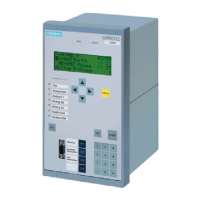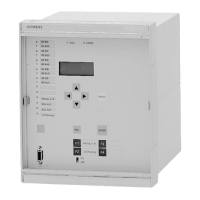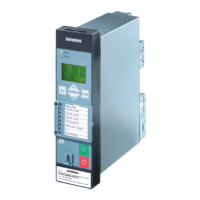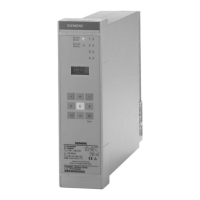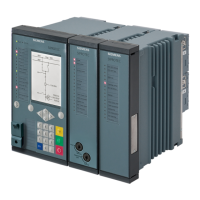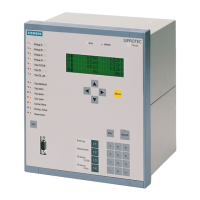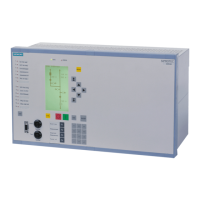

Do you have a question about the Siemens SIPROTEC and is the answer not in the manual?
| Brand | Siemens |
|---|---|
| Model | SIPROTEC |
| Category | Protection Device |
| Language | English |
Describes the basic structure and operation of the line differential protection 7SD5, including analog inputs and microcomputer system.
Details the application scope of the 7SD5 line protection relay, covering differential and distance protection capabilities.
Lists general features of the device, differential protection, distance protection, and power swing supplement.
Provides general information about device settings, interaction with substation, and protection functions.
Explains how devices exchange data via protection data interfaces for differential protection.
Describes the basic principle of differential protection for lines, including multiple ends and transmission of measured values.
Details the distance protection function, including general settings, fault detection, and pickup modes.
Explains the integrated power swing supplement for blocking or tripping during power swings.
Describes teleprotection schemes for achieving instantaneous and selective tripping.
Covers protection functions for high-resistance earth faults in earthed systems, including overcurrent stages.
Explains how directional earth fault protection can be expanded with directional comparison schemes.
Focuses on detecting earth faults in power transformers with earthed starpoints.
Addresses protection for line ends with weak or no infeed, including echo and weak infeed tripping.
Explains how external signals can be coupled for local circuit breaker control.
Describes the transmission of binary information between devices for protection and control.
Details the function for disconnecting feeders switched onto high-current faults immediately.
Covers earth fault detection in non-earthed or compensated systems, including directional determination.
Describes the integrated time overcurrent protection function for backup or emergency use.
Explains the integrated automatic reclosure function for overhead lines and its operational modes.
Details the function for checking network stability before switching a line onto a busbar.
Covers protection against abnormal voltage conditions like overfrequency and underfrequency.
Explains the function for detecting overfrequencies or underfrequencies in the system.
Describes the function for measuring the distance to a fault, aiding in fault localization.
Provides rapid back-up fault clearance when the circuit breaker fails to respond to a trip command.
Details the function to prevent damage to protected objects caused by thermal overloading.
Covers various monitoring capabilities including hardware, software, and measurement supervision.
Explains how to control functions and perform circuit breaker tests for optimal device operation.
Provides guidelines for the proper mounting and electrical connections of the device.
Details how to check data connections of serial interfaces, protection data communication, and system connections.
Outlines the procedures for testing the device's functions, including test mode and system interface checks.
Covers final steps before device operation, such as checking settings and resetting buffers.
Lists general technical data, including analog inputs, current transformer requirements, and voltage inputs.
Details technical data for protection data interfaces and differential protection topology.
Provides technical data for differential protection, including pickup values and intertripping times.
Lists technical data for restricted earth fault protection, including setting ranges and operating times.
Details technical data for breaker intertrip and remote tripping functions.
Provides technical data for distance protection, including earth impedance ratios and pickup modes.
Lists technical data for power swing detection, including blocking programs and tripping criteria.
Details technical data for teleprotection schemes used with distance protection.
Covers technical data for earth fault protection, including definite time and inverse time stages.
Lists technical data for teleprotection schemes used with earth fault protection.
Provides technical data for weak infeed tripping, including undervoltage and time settings.
Details technical data for French specification weak infeed tripping.
Lists technical data for remote trip commands and transmission of binary information.
Provides technical data for the SOTF function, including pickup values and trip times.
Lists technical data for earth fault detection in non-earthed systems.
Describes technical data for backup time overcurrent protection, including definite and inverse time stages.
Covers technical data for the automatic reclosure function, including operating modes and times.
Provides technical data for synchronism and voltage check functions.
Lists technical data for undervoltage and overvoltage protection stages.
Explains technical data for frequency protection, including pickup values and time delays.
Describes technical data for the fault locator function, including settings and output.
Lists technical data for circuit breaker failure protection and its initiation conditions.
Covers technical data for thermal overload protection, including setting ranges and calculation methods.
Details technical data for various monitoring functions like current symmetry and voltage symmetry.
Provides technical data for user-defined functions using CFC, including function blocks and limits.
Contains information on ordering devices and related accessories, including order codes and interface modules.
Details terminal assignments for panel flush mounting, cubicle mounting, and surface mounting configurations.
Provides examples for connecting current transformers and voltage transformers for various protection functions.
Lists default settings for LEDs, binary inputs, binary outputs, and function keys.
Explains functions dependent on communication protocols like IEC 60870-5-103, IEC 61850, PROFIBUS, and DNP 3.0.
Outlines the available functions and their configurations, including distance protection and earth fault protection.
Provides detailed tables of all parameters and their corresponding settings for various functions.
Lists all available indications and their associated function numbers and descriptions.
Lists grouped alarms with their respective functions and descriptions.
Details operational measured values for currents, voltages, power, frequency, and differential protection.
